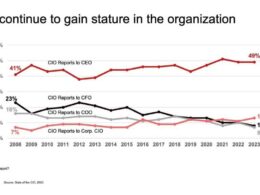This is a republication of an excerpt of the paper “Successful Digital Transformation is All About Value”, with the title above.
Harvard Business Review
by Stephanie L. Woerner, Peter Weill, Ina M. Sebastian
October 21, 2022
Chief Researcher and Site Editor:
Joaquim Cardoso MSc.
the health transformation
October 28, 2022
Summary (of the long version of the paper)
In the digital era, how firms create and capture value has changed profoundly.
But with digital transformation, many firms are leaving substantial value on the table, getting caught up in “doing” digital transformation rather than staying focused on how they will create and capture value with digital.
To do this, first companies need to understand the three different types of digital value:
- value from customers (cross-selling, increased loyalty, great customer experience);
- value from operations (increased efficiency, modularity and reuse of components, automating processes); and
- value from ecosystems (leveraging partners for both access to more customers and range of products and services).
With these types of value in mind, firms can then take action to create digital value by:
- identifying domain opportunities;
- building mutually-reinforcing capabilities;
- tracking digital value with a dashboard;
- recruiting digital partners; and
- investing in digital savviness of everyone at the firm.
Companies that do this will become truly “future ready.”
ORIGINAL PUBLICATION [excerpt]

Firms are leaving 50%+ on average of potential digital value on the table — why is that? [excerpt 1]
A global financial services firm we worked with really seemed to get the digital message.
They hired a chief digital officer who led many locally successful projects to improve the customer experience.
These included making it easier to move from in-person to online for certain tasks, plus targeted offers based on customer data.
They felt confident they were creating great customer value.
But there was a problem.
Those local innovations ended up adding more complexity to the existing fragmented business processes, systems, and data.
Although the customer experience often improved — and in some cases, revenue increased — the rise in the cost-to-serve eclipsed the gains and added other risks like cybersecurity and system crashes.
But there was a problem. The local innovations ended up adding more complexity to the existing fragmented business processes, systems, and data.
Although the customer experience often improved — and in some cases, revenue increased — the rise in the cost-to-serve eclipsed the gains and added other risks like cybersecurity and system crashes.

In the digital era, how firms create and capture value has changed profoundly.
But most aren’t keeping up.
Our research shows that the average firm today is leaving an eye-opening 50% of potential digital value or more on the table, compared to leading firms.
… the average firm today is leaving an eye-opening 50% of potential digital value or more on the table, compared to leading firms.
In our experience working with global enterprises in every industry, the main reason for this seems clear:
firms often get caught up in thinking about “doing” a digital transformation initiative rather than thinking concretely about how they will create and then capture value with digital.
In our experience working with global enterprises in every industry, the main reason for this seems clear: firms often get caught up in thinking about “doing” a digital transformation initiative …
… rather than thinking concretely about how they will create and then capture value with digital.

The focus should start and end with value.
This means changing the way you think, operate, develop talent, keep score, organize, partner, and innovate to compete in the digital economy.
We call companies that are doing this “future ready,” and the most successful among them are generating 70% or more of the potential value from their digital initiatives — significantly more than the average firm.












